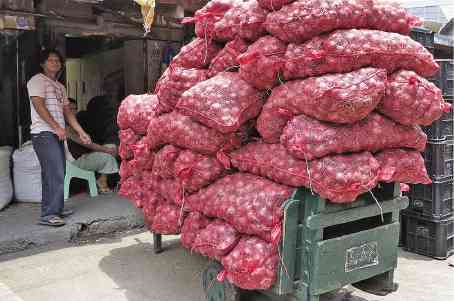Nueva Ecija onion growers cry over woes faced by industry

Onion is the second major crop of Nueva Ecija. Farmers, however, are struggling due to cheaper imported onions, smuggling and erratic weather. —EV ESPIRITU
CABANATUAN CITY—Onions have been making farmers weep, as importation, smuggling and climate change take their toll on farmlands in Nueva Ecija, the country’s top producer of the crop.
About 3,000 hectares of onion plants were affected by armyworms recently, bringing down harvests, said Gregorio Quiñones, high-value crops coordinator of the provincial agricultural office.
Nueva Ecija accounts for at least 55 percent of the Philippines’ onion production, according to the Department of Agriculture. In 2013, it produced 73,911.12 metric tons of the national output of 134,169.92 MT.
At least 23 towns and cities in Nueva Ecija are producing onions every season, Quiñones said. Farmers plant from October to January, with harvest peaking in March.
Problems
Article continues after this advertisementThe province supplies red onions (locally known as sibuyas Bombay or sibuyas pula), yellow or white onions (sibuyas na puti) and shallots (sibuyas Tagalog or tanduyong).
Article continues after this advertisementBut a succession of problems has been plaguing onion growers.
In 2000, about 700 farmers in San Jose City allowed their harvest to rot because the buying price was only P2 to P3 per kilogram. Many in other towns stopped harvesting their yellow onions.
Also adversely affecting the industry were the results of a Department of Justice investigating team showing that one agricultural group was given 305 of the 585 import permits issued by the Bureau of Plant Industry (BPI) from 2011 to 2013. The team also found that certain cooperatives sold to Chinese traders the import permits granted them by the BPI.
Unreasonable importation
On Nov. 11, onion growers in northern Luzon gathered in Cabanatuan City to stage a rally against what they described as unreasonable importation, which had affected the price of their crops.
Quiñones said the province found no evidence that excessive importation had affected locally produced onions.
“We found no onion stocks in cold storage plants as we went around with BPI personnel checking inventories,” he said. “Our province was really short of the usual production output,” he added.
What should be pursued instead is the dismantling of the onion cartel, the establishment of more credits or subsidies for farmers, and the lowering of cost of production, he said.
“As for the destruction of plants by natural calamities, it is one downside that causes farmers here to tear up,” he said.
Bongabon town is Nueva Ecija’s top producer and has been called as “the onion basket of the Philippines.” In 2013, its total yield was 39,300 MT, of which 30,445 MT were red onions and the rest the yellow variety.
According to the provincial agricultural office, 3,044 ha of farms were concentrated on onion production in Bongabon out of the 8,907 ha in other towns and cities.
Gabaldon and Rizal are the other big onion producers, with Gabaldon generating 9,543 MT of red onions and Rizal growing 8,670 MT of red and yellow varieties. San Jose City produced 6,573 MT of red onions and 1,508 MT of the yellow variety in 2013. The city’s farmers, however, did better with red shallots with an output of 21,319 MT.
Nueva Ecija’s journey with onion growing started in 1935 when Nicolas Ruiz, a farmer from Muñoz town (before it became a science city) experimented on onion farming using seeds given by the Maligaya experiment station.
Quiñones said farmers spend about P130,000 a hectare for growing onions. “The break-even buying price is P14 to P15 a kg for an average yield of 9 tons a hectare,” he said.
He said most farmers get capitalization from Chinese traders, who corner the yield at dictated farm gate price.
Many bags of onions, Quiñones said, are kept in storage facilities for months and are sold in the market for as high as P80 a kg in September and P85 a kg in November. Imported onions cost less than half of that selling price.